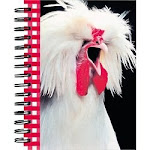
FEED: Use a commercial chick starter for the first 8 weeks. On the first day cover the litter with newspaper and spread some feed on the papers and have your feeders full also. This will allow the new birds to find the feed. Use a 2 foot feeder for each 25 chicks. After the first day remove the papers from the starting area. (Paper left down too long will cause a condition called waddle and can handicap your chicks)
WATER: Have a 1 gallon chick waterer for each 50 birds. DIP BEAK OF THE CHICK IN THE WATER BEFORE YOU TURN IT LOOSE. (note.. Please also be sure to put large pebbles, small rocks, into the waterer to keep the chicks from drowning themselves) For the first 2 days add 3 tablespoons of table sugar to each quart of water for extra energy. For best results, have either Quik Chik, Broiler Booster, or Terramycin in the water. Your birds will be thirsty when you get them, or start them,. A taste of water right away helps them to find more water soon. Most baby bird loss is caused because the bird doesn't start to eat or drink. Never let your birds run out of water.
HEAT: The temperature where the birds are should be 90 to 95 degrees for the first week. Reduce the temperature 5 degrees per week until you get to 70 degrees. Then they shouldn't need heat anymore.
A good source of heat is a 250 watt heat bulb. (Red are better than white. They cause less picking.) Hang it 18 inches from the floor. The temperature directly under the bulb will be higher than 90 degrees but the birds will adjust themselves to the area they like. Use 1 bulb for each 50 chicks in cold weather.
LIGHT: If you use a heat bulb, this will also serve as the light you need. Otherwise, be sure you give your birds light. Use a 75 watt bulb on dark days. Have a small light for night ~15 watts or similar~ to keep them from piling.
SPACE: Try to provide 1/2 square foot per bird at the start. For starting 50 chicks use a draft shield (Cardboard put into a circle about 12 inches high around the birds. Be sure the circle is large enough to allow the birds to get away from the heat if they want to.) and make a circle about 5 to six feet across. For 100 birds, make the circle 7 to 8 feet across.
LITTER: Wood shavings, rice hulls, or ground cobs make good litter. Do not use cedar chips, sawdust (It is too small and the birds may eat it instead of their food) or treated wood chips. Sand, straw, or dirt will also work but are not as good as the others.
GRIT: Starting the 3rd day sprinkle baby grit on the feed daily as if you were salting your food. Avoid putting too much at any one time as the birds may fill up on it instead of the feed.
PICKING: Baby birds will often pick each other if they are too hot, too crowded, or without fresh air. Occasionally, bright light also causes them to pick. An ounce of prevention is worth a pound of cure when it comes to picking. To stop picking, try putting in fresh green grass clippings several times a day and darken the room. To treat the picked bird use an anti pick product or smear black grease on the area injured and keep up the treatment until healed.
PASTING UP: Sometimes the birds accumulate feces' on its rear end. It is important to remove it daily. Pull off gently, or better yet, wash off with a cloth and warm water. It will disappear in a few days as the bird starts to grow.




































